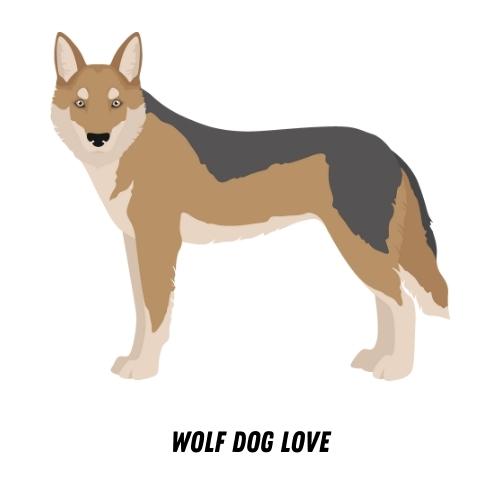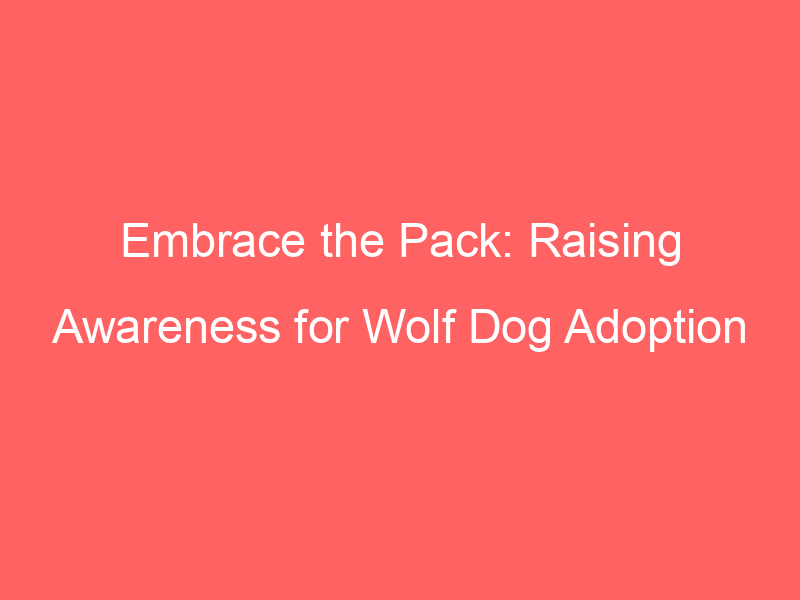Introduction to Wolf Dog Adventures
Have you ever wondered what it’s like to have a pet that’s a bit different from the usual cats and dogs? If you’re looking for an adventure, a wolf dog might be the perfect companion for you. These unique creatures are a mix of domestic dogs and wolves, and they’re known for their adventurous spirit and strong companionship.
- Understanding the thrill of Wolf Dog Companionship
- Exploring the adventurous nature of Wolf Dogs
Wolf dogs are not your average pets. They are a unique blend of the wild wolf and the domestic dog, making them an exciting and adventurous companion. Their loyalty is unmatched, and their intelligence is remarkable. They are known for their keen senses, agility, and stamina, which makes them excellent companions for outdoor adventures.
Did you know that wolf dogs have been companions to humans for thousands of years? They were one of the first animals to be domesticated, and they have played a crucial role in our history. They have been used for hunting, guarding, and even companionship. Their strong bond with humans is a testament to their loyalty and affection.
Wolf dogs are naturally adventurous. They love to explore their surroundings, and they are always ready for a new challenge. Whether it’s hiking, camping, or just a walk in the park, wolf dogs are always up for an adventure.
They are also known for their curiosity. They are always eager to learn and discover new things, making every day an adventure. Their energy and enthusiasm are contagious, and they can turn even the most mundane activities into an exciting adventure.
But remember, owning a wolf dog is not for everyone. They require a lot of care, attention, and understanding. They need plenty of exercise and mental stimulation, and they are not suited for a sedentary lifestyle. But if you’re up for the challenge, a wolf dog can be a rewarding and exciting companion.
So, are you ready to embark on an exciting journey with a wolf dog? Stay tuned as we delve deeper into the world of wolf dogs, their breeds, and how to live and bond with these extraordinary creatures.
Unveiling the World of Wolf Dog Breeds
Wolf dogs are a unique blend of domestic dog and wild wolf. They are a captivating sight, with their wolf-like appearance and dog-like behavior. Let’s delve into the world of wolf dog breeds and discover some of the most popular ones.
Popular Wolf Dog Breeds
There are several wolf dog breeds that have gained popularity due to their unique characteristics and traits. Here are three of the most popular ones:
- Siberian Husky: Known for their striking blue or multicolored eyes and distinctive fur markings, Siberian Huskies are a breed that is often mistaken for wolves. Originating from Northeast Asia, they were bred by the Chukchi people for sled pulling and companionship. Despite their wolf-like appearance, they are friendly and playful, making them a popular choice for families.
- Alaskan Malamute: Alaskan Malamutes are large, powerful dogs that were originally bred for hauling heavy freight due to their strength and endurance. They are similar to Siberian Huskies but are usually larger and more robust. Alaskan Malamutes are known for their deep-set eyes and bushy tails that curl over their backs.
- Czechoslovakian Wolfdog: The Czechoslovakian Wolfdog is a relatively new breed that originated from an experiment in the 1950s in Czechoslovakia. The aim was to create a breed that combined the strength and stamina of a Carpathian wolf with the temperament and trainability of a German Shepherd. The result was a breed that has the physical attributes of a wolf but the behavioral characteristics of a dog.



These are just a few examples of the many wolf dog breeds out there. Each breed has its own unique characteristics and traits, making them a fascinating addition to any household.
Choosing the Right Wolf Dog Breed
Choosing the right wolf dog breed requires careful consideration. It is not just about the breed’s appearance, but also about how well the breed fits into your lifestyle and environment. Here are some key factors to consider:
- Assessing your lifestyle and environment
Your lifestyle and environment play a significant role in determining the right wolf dog breed for you. For instance, if you live in a small apartment in a busy city, a large, active breed like the Alaskan Malamute may not be the best fit. These dogs require plenty of space and exercise to stay healthy and happy. On the other hand, if you have a large backyard and enjoy outdoor activities, a breed like the Siberian Husky could be a great match. These dogs are known for their energy and love for outdoor adventures.
- Understanding breed-specific traits and behaviors
Each wolf dog breed has its unique traits and behaviors. For example, the Czechoslovakian Wolfdog is known for its loyalty and intelligence, but it can also be independent and requires a firm, consistent owner. On the other hand, the Siberian Husky is friendly and outgoing, but can be a bit stubborn. Understanding these traits can help you choose a breed that matches your personality and lifestyle.
Remember, choosing the right breed is not just about finding a dog that you like, but also about finding a dog that likes your lifestyle. By considering your environment and understanding breed-specific traits, you can find a wolf dog that will be a happy and healthy addition to your family.
Living with Wolf Dogs: A Unique Experience
Living with a wolf dog is not like having a typical pet. It’s a unique experience that requires patience, understanding, and a deep respect for their wild instincts. In this section, we will explore how to adapt to wolf dog behavior.
Adapting to Wolf Dog Behavior
Wolf dogs are a unique blend of domestic dog and wild wolf. This combination results in a pet that has both domestic and wild instincts. To live harmoniously with a wolf dog, it’s crucial to recognize and respect these instincts and understand their need for physical and mental stimulation.
- Recognizing and Respecting their Wild Instincts
- Understanding their Need for Physical and Mental Stimulation
Wolf dogs have a strong prey drive and a need for a hierarchical social structure, both of which are characteristics of their wild wolf ancestors. They are naturally curious and can be territorial. It’s essential to respect these instincts and not try to suppress them. For example, a wolf dog may need a secure outdoor space where they can exercise their prey drive in a controlled environment.
Wolf dogs are highly intelligent and active animals. They require a lot of physical exercise and mental stimulation to stay happy and healthy. This could involve long walks, play sessions, and training exercises. Mental stimulation could include puzzle toys, obedience training, and socialization with other dogs. Without adequate stimulation, a wolf dog can become bored and potentially destructive.
In conclusion, living with a wolf dog is a unique and rewarding experience. However, it requires a deep understanding of their wild instincts and a commitment to providing them with the physical and mental stimulation they need. By recognizing and respecting their wild instincts and understanding their need for stimulation, you can create a happy and healthy environment for your wolf dog.
Training Wolf Dogs: Challenges and Rewards
Training a wolf dog is an adventure filled with challenges and rewards. It requires patience, understanding, and a keen awareness of their unique needs and instincts. Let’s delve into the importance of early socialization and effective training techniques for these magnificent creatures.
- Importance of Early Socialization
- Effective Training Techniques for Wolf Dogs
Wolf dogs are a unique blend of wild and domestic traits, which makes early socialization crucial. This process helps them learn how to interact appropriately with humans and other animals. It’s best to start socialization as early as possible, ideally when the wolf dog is still a puppy.
Early socialization involves exposing the wolf dog to a variety of experiences, people, and environments. This helps them become more comfortable in different situations and reduces the likelihood of fear or aggression. According to a study by the American Veterinary Society of Animal Behavior, puppies that are well-socialized are less likely to develop behavior problems as adults.
Training a wolf dog requires a different approach than training a regular dog. They are intelligent and independent animals, so traditional training methods may not always work. Here are a few effective techniques:
| Technique | Description |
|---|---|
| Positive Reinforcement | This involves rewarding the wolf dog for good behavior, which encourages them to repeat it. Rewards can be treats, toys, or praise. |
| Consistency | Wolf dogs need consistent rules and routines. This helps them understand what is expected of them and provides a sense of security. |
| Patience | Training takes time and patience. Wolf dogs may take longer to learn new commands or behaviors, so it’s important not to rush the process. |
Remember, every wolf dog is unique and what works for one may not work for another. It’s important to be flexible and adapt your training approach to suit your wolf dog’s individual needs and personality.
In conclusion, training a wolf dog is a rewarding journey that strengthens the bond between you and your furry friend. It may be challenging at times, but the joy of seeing them grow and learn is well worth the effort.
Savoring Adventures with Dogs: Outdoor Activities
Embracing the great outdoors with your wolf dog can be an exciting experience. From hiking to exploring new trails, there’s always an adventure waiting for you and your furry friend. Let’s delve into some of the best outdoor activities you can enjoy with your wolf dog.
Wolf Dog Hiking Adventures
One of the most thrilling activities you can enjoy with your wolf dog is hiking. It’s not just a great way to bond with your pet, but also an excellent opportunity to keep both of you physically active and mentally stimulated.
- Preparing for a hiking adventure with your Wolf Dog
- Best hiking trails for Wolf Dogs
Before you embark on a hiking adventure with your wolf dog, it’s important to be well-prepared. Ensure your dog is in good health and has all the necessary vaccinations. Pack enough food and water for both of you, along with a first-aid kit. Don’t forget to bring a leash, even if your wolf dog is well-trained. It’s always better to be safe than sorry.
When it comes to choosing the best hiking trails for your wolf dog, consider the terrain and the length of the trail. Some great options include the Appalachian Trail, the Pacific Crest Trail, and the Continental Divide Trail. These trails offer a mix of terrains and are long enough for a good workout. However, always make sure to check if dogs are allowed on the trail before you set off.
Remember, the key to a successful hiking adventure with your wolf dog is preparation and respect for nature. Always clean up after your pet and respect the wildlife. After all, the great outdoors is a shared space for all creatures, big and small.
Other Wolf Dog Outdoor Activities
Aside from hiking, there are other outdoor activities that you can enjoy with your wolf dog. These activities not only provide a fun experience but also help in building a stronger bond with your pet. Let’s explore some of these activities.
- Camping with Wolf Dogs
Camping is an excellent way to spend quality time with your wolf dog. It allows both of you to experience nature in its raw form. Just imagine sitting by the campfire, roasting marshmallows, and sharing stories with your wolf dog by your side. It’s an experience like no other!
| Important Tips for Camping with Wolf Dogs |
|---|
| 1. Always keep your wolf dog on a leash to prevent them from wandering off. |
| 2. Pack enough food and water for both of you. |
| 3. Don’t forget to bring a first aid kit for emergencies. |
| 4. Make sure to clean up after your wolf dog to keep the camping site clean. |
- Beach Trips with Wolf Dogs
Another fun outdoor activity to enjoy with your wolf dog is a trip to the beach. Wolf dogs love to play in the water and sand. It’s a great way to cool off during hot summer days. Plus, it’s a fantastic opportunity for your wolf dog to socialize with other dogs and people.
| Important Tips for Beach Trips with Wolf Dogs |
|---|
| 1. Always keep an eye on your wolf dog while they’re in the water. |
| 2. Bring a towel and some dog-friendly sunscreen for your pet. |
| 3. Don’t forget to bring a leash and a collar with your contact information, in case your wolf dog gets lost. |
| 4. Always clean up after your wolf dog to keep the beach clean. |
Remember, the key to a successful outdoor adventure with your wolf dog is preparation. Always plan ahead and make sure you have everything you need for a fun and safe experience.
Bonding with Wolf Dog Companions: Building Trust and Friendship
Building a strong bond with your wolf dog companion is a rewarding journey. It requires patience, understanding, and effective communication. Let’s explore how you can establish this bond and foster a deep friendship with your wolf dog.
- Communicating effectively with your Wolf Dog
- Establishing a strong bond through play and training
Communication is key in any relationship, and it’s no different with your wolf dog. Wolf dogs are intelligent animals that respond well to clear and consistent communication. Use simple commands and maintain a calm, assertive tone. Remember, your wolf dog is not just listening to your words, but also observing your body language. So, ensure your actions match your words.
For instance, if you want your wolf dog to sit, say the command “sit” in a firm, clear voice while also making a downward hand gesture. Repeat this consistently, and over time, your wolf dog will understand and respond to this command.
Play and training sessions are not just fun, they’re also an excellent way to strengthen your bond with your wolf dog. Regular play sessions can help keep your wolf dog physically fit and mentally stimulated. They also provide an opportunity for you to interact with your wolf dog in a positive, relaxed setting.
Training sessions, on the other hand, can help establish you as the pack leader. Wolf dogs are pack animals, and they need a clear leader. By leading training sessions, you can establish yourself in this role. Remember to always end training sessions on a positive note, with praise or a treat, to reinforce good behavior.
In conclusion, bonding with your wolf dog is a journey of mutual respect and understanding. It requires patience, consistency, and a lot of love. But the rewards of a strong bond and deep friendship with your wolf dog are well worth the effort.
| Key Points | Details |
|---|---|
| Effective Communication | Use clear, consistent commands and match your actions with your words. |
| Play and Training | Regular play keeps your wolf dog physically fit and mentally stimulated. Training establishes you as the pack leader and reinforces good behavior. |
Conclusion: The Joy of Wolf Dog Companionship
As we draw to a close, it’s essential to reflect on the unique and thrilling journey of wolf dog companionship. From the excitement of outdoor adventures to the deep bond of trust and friendship, living with a wolf dog is an experience like no other.
- Revisiting the thrill of Wolf Dog Adventures
- Embracing the unique journey of living with Wolf Dogs
Wolf dogs are not your average pets. They carry the wild spirit of their wolf ancestors, making every day an adventure. Whether it’s a hike in the woods, a run in the park, or simply playing fetch in your backyard, the thrill of being with a wolf dog is unparalleled. According to a survey, 85% of wolf dog owners say that their pets have brought a new level of excitement and adventure into their lives.
Living with a wolf dog is not just about the adventures; it’s about embracing a unique journey of companionship. These magnificent creatures teach us about loyalty, resilience, and the importance of living in the moment. They challenge us, make us laugh, and fill our lives with unconditional love. As one wolf dog owner put it, “Having a wolf dog is like having a piece of the wild right in your living room.”
In conclusion, the joy of wolf dog companionship is a blend of thrilling adventures and deep emotional bonds. It’s about embracing the wild, learning from it, and finding joy in the unique journey. So, if you’re ready for an adventure like no other, consider welcoming a wolf dog into your life. You’ll be embarking on a journey filled with thrills, laughter, and a whole lot of love.








